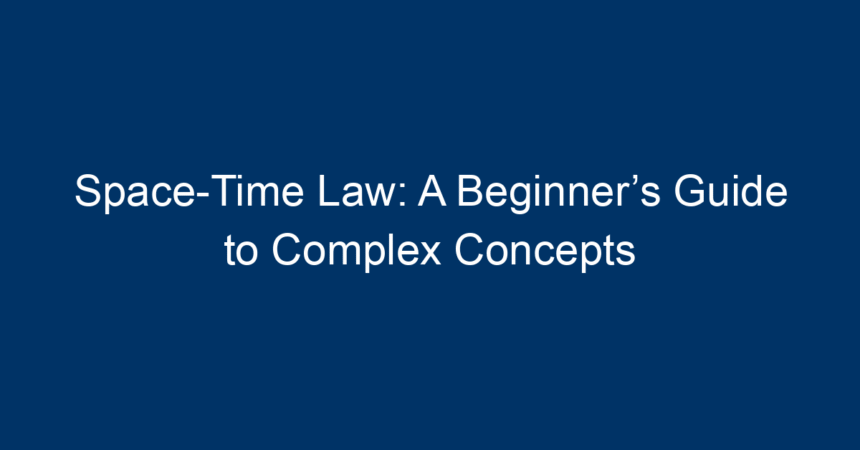Introduction
In the ever-expanding universe of scientific inquiry, few subjects provoke as much curiosity and confusion as the concept of space-time law. This fascinating interdisciplinary field combines elements of physics, philosophy, and even mathematics to explore the fundamental structure of our universe. For beginners, navigating the complexities of space-time can feel overwhelming. However, this guide aims to demystify these concepts, providing clear explanations and actionable insights that can help you grasp the exciting parameters of space-time law.
What is Space-Time Law?
At its core, space-time law is rooted in the understanding that space and time are interconnected. This fusion of dimensions alters our perceptions of reality, challenging conventional notions of time and space as independent entities. Albert Einstein’s Theory of Relativity fundamentally shifted how scientists and thinkers perceive these elements, leading to groundbreaking implications for various fields.
The Basics of Space and Time
Before diving into the intricacies of space-time law, it is essential to understand the basic concepts of space and time:
-
Space: Typically divided into three dimensions—length, width, and height—space is the physical universe we inhabit.
- Time: Often viewed as a linear progression of events from past to future, time is a more elusive concept, with philosophers and scientists debating its nature for centuries.
The Fusion of Space and Time
Einstein’s groundbreaking work synthesized these two concepts into a four-dimensional continuum known as space-time. This paradigm shift laid the groundwork for the space-time law, which posits that objects moving through space also experience the passage of time differently based on their speed and gravitational fields.
The Historical Context of Space-Time Law
Understanding the historical development of space-time law is crucial for grasping its present implications.
Pre-Einsteinian Views
Before Einstein, space and time were largely treated as separate entities. Classical Newtonian physics positioned time as an absolute timeline against which events occurred. This linear framework limited the understanding of how objects interacted at high speeds or in strong gravitational fields.
Einstein’s Revolution
Einstein’s Special Relativity (1905) introduced the idea that the laws of physics are the same for all observers, regardless of their relative speeds. This principle led to the realization that space and time are not independent but are deeply intertwined. His General Relativity (1915) further expanded on this by demonstrating how mass could warp the fabric of space-time, creating gravitational effects that could bend light and influence the passage of time.
Space-Time and Quantum Mechanics
The emergence of quantum mechanics in the early 20th century brought new challenges to the space-time law framework. While general relativity excels at explaining large-scale phenomena, it struggles with quantum effects at microscopic scales. This continues to be an area of intense research, leading scientists to seek a unifying theory that incorporates both realms.
Key Concepts of Space-Time Law
Understanding space-time law requires familiarity with several key concepts that underpin its principles. Here are some essential terms to know:
1. Time Dilation
One of the most fascinating implications of space-time law, time dilation, refers to the phenomenon where time moves slower for an object in motion compared to a stationary observer. This effect, predicted by Einstein, has been confirmed in countless experiments and has profound implications for space travel and GPS technology.
2. Gravitational Time Dilation
In addition to speed, gravity also affects the flow of time. Near a massive object, such as a black hole, time flows more slowly than it does in a less gravitationally intense environment. This concept has significant implications for understanding how time behaves on a cosmic scale.
3. Spacetime Geometry
The geometry of space-time is non-Euclidean; it introduces concepts such as curvature. Massive objects like planets and stars warp the fabric of space-time around them, influencing the movement of other objects. This curvature explains gravitational attraction in a more nuanced way than classical physics does.
4. Black Holes and Event Horizons
Black holes represent one of the most extreme manifestations of space-time law. Once matter crosses the event horizon, the boundary surrounding a black hole, it cannot escape. Here, the gravitational pull is so strong that it effectively deforms space and time, raising questions about the limits of our understanding.
Real-World Applications of Space-Time Law
While space-time law may seem abstract, it has practical applications across various domains:
1. GPS Technology
Global Positioning System (GPS) relies on accurate time measurements from satellites, which orbit Earth at high speeds. Without accounting for time dilation effects, GPS would quickly become inaccurate, demonstrating the real-world implications of space-time law.
2. Astrophysics
Astrophysicists utilize concepts from space-time law to analyze cosmic events, such as the behavior of stars near black holes or the expansion of the universe. Understanding these interactions enriches our comprehension of the cosmos.
3. The Future of Space Travel
As humanity considers longer space missions—such as journeys to Mars—grasping space-time law will become increasingly important. Understanding how time dilation may affect communication and physiological changes during long-term space travel is crucial for the success of these missions.
Future Directions in Space-Time Research
The journey into understanding space-time law is far from over. Several exciting areas of research continue to challenge and expand our knowledge:
1. Quantum Gravity
One of the most significant unsolved problems in physics is the quest for a theory that unites general relativity and quantum mechanics, often referred to as "quantum gravity." Researchers aim to find equations that accurately describe gravity within the framework of quantum theory.
2. Multiverse Theories
Some physicists theorize the existence of a multiverse, where multiple universes exist with their own distinct space-time laws. Exploring this idea raises profound questions about the nature of reality and our place in it.
3. Time Travel
While often relegated to science fiction, time travel encompasses real theoretical frameworks. Concepts such as wormholes and cosmic strings challenge our understanding of causality and the linear nature of time.
Conclusion
Navigating the complexities of space-time law may seem daunting, but grasping these fundamental concepts opens a world of possibilities. From understanding the nature of our universe to practical applications in technology and future explorations, space-time law offers a compelling glimpse into the very fabric of reality.
Actionable Insights
- Start Small: Dive into the basics of relativity and time dilation before tackling more complex theories.
- Engage with Online Resources: Numerous online lectures and courses are available for those interested in deepening their understanding of space-time law.
- Join Discussion Groups: Engage with others who share your interest. Online forums and local science clubs can provide a platform for learning and discussion.
Embarking on your journey to understand space-time law could unlock new perspectives on reality, enriching your appreciation for the universe and your place within it.




